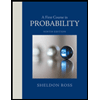vo sixes in a row. Your task =, required to roll two sixes init
A First Course in Probability (10th Edition)
10th Edition
ISBN:9780134753119
Author:Sheldon Ross
Publisher:Sheldon Ross
Chapter1: Combinatorial Analysis
Section: Chapter Questions
Problem 1.1P: a. How many different 7-place license plates are possible if the first 2 places are for letters and...
Related questions
Question

Transcribed Image Text:Calculate the average number of rolls of one dice, required to roll two sixes in a row.
Instructions how to proceed:
a) assignment means that we will roll the dice until two sixes fall in a row.
Of course, these Sixes will only fall in the last two throws, and that's when we finish. Number of throws,
what we did is the number of throws needed to roll two sixes in a row. Your task
is to calculate the average number of rolls of one dice, required to roll two sixes
after myself. We get the average number by repeating said experiment infinite
number of times and calculate the average of the results obtained
b) Let's call "a;" the probability that with consecutive rolls of "i" one die will not fall
out twice in a row six, and with the last roll six will fall out.
Let's call "b;" the probability that with consecutive rolls of "i" one die will not fall
out twice in a row six, and with the last roll six will not fall out
c) Probabilities "a;" and "b;" form sequences {a;}X=o and {b¡}k=o
100
Their first terms are ao
= 0 and bo = 1.
Construct a system of recurrent relationships for {a;}-o and {b;}%=0 sequences and find the forming functions a(x) and b(x) for these
sequences.
d) Let's designate "p;"the probability of falling in "į" consecutive rolls with one dice exactly once two sixes in a row in the last two throws.
e) The probabilities of pi form a sequence {p;}=0 whose first terms are p, = 0 and p, = 0. Find the generating function p(x) for the sequence
{p}}%=0
f) The average number of rolls of one dice required to roll two sixes in a row is calculated as:
Efo i. Pi
(1)
P =
Formula (1) is easy to prove, but that's not your job. Take Formula (1) as a given fact.
g) using Formula (1) Calculate the average number of rolls of one dice required
to throw two sixes in a row.
Expert Solution
This question has been solved!
Explore an expertly crafted, step-by-step solution for a thorough understanding of key concepts.
Step by step
Solved in 2 steps

Recommended textbooks for you

A First Course in Probability (10th Edition)
Probability
ISBN:
9780134753119
Author:
Sheldon Ross
Publisher:
PEARSON


A First Course in Probability (10th Edition)
Probability
ISBN:
9780134753119
Author:
Sheldon Ross
Publisher:
PEARSON
